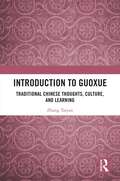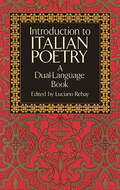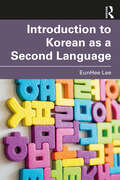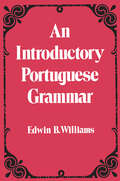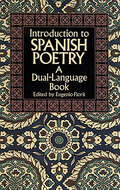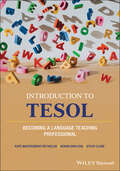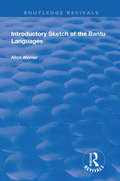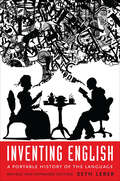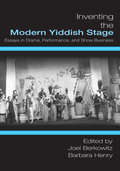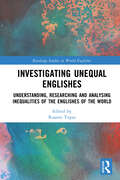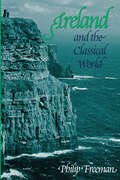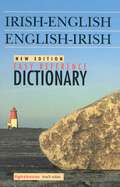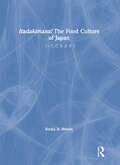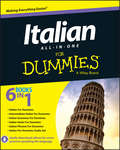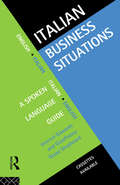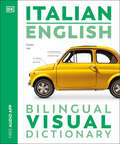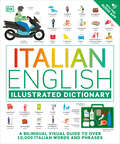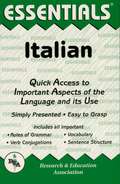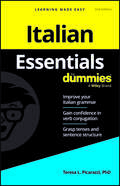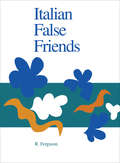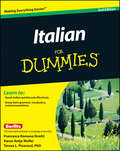- Table View
- List View
Introduction to Guoxue: Traditional Chinese Thoughts, Culture, and Learning
by Zhang TaiyanThis book is a collection of Zhang Taiyan's lectures on traditional Chinese thoughts, culture, and learning. Zhang Taiyan is known for his role as an active proponent of Guoxue (Chinese learning) in modern China. This title comprises the transcripts of a series of his lectures on Guoxue given in Shanghai between April and June 1922, and serves as an insightful and influential companion to Guoxue. It systematically introduces the research methods of Guoxue and the development and schools of Chinese classical studies, Chinese philosophy, and Chinese literature, and provides a brilliant analysis of representative figures and works from various periods. It also touches on a wide range of topics in Chinese history, philology, paleography, bibliology, and geography. This book provides Guoxue with many new and thought-provoking ideas and plays a crucial role in the dissemination of Guoxue throughout the world. This title will be essential reading for students and scholars of Sinology and Chinese Studies, as well as for the general public interested in traditional Chinese culture.
Introduction to Italian Poetry: A Dual-Language Book (Dover Dual Language Italian)
by Luciano RebayThis anthology highlights seven centuries of Italian poetry that will help you learn the language as well. Included are 34 examples of Italian verse in the original with English translations on facing pages. Twenty-one poets are represented, from Saint Francis of Assisi, author of the first memorable Italian lyric, "Cancio delle creature," to Salvatore Quasimodo, winner of the 1959 Nobel Prize for Literature. Also included are works by Dante, Petrarch, Ariosto, Tasso, and Montale, as well as such lesser known but significant poets as Compiuta Donzella and Cavalcanti. There are even important works by Boccaccio and Michelangelo.In addition to full Italian texts with expert literal translations on facing pages, this edition contains a wealth of biographical and critical commentary.
Introduction to Korean as a Second Language
by EunHee LeeIntroduction to Korean as a Second Language introduces the basic linguistic make-up of Korean and provides basic knowledge of second language acquisition and up-to-date research on how Korean is learned by adult second language learners (L2 Korean learners).The book synthesizes the existing research and suggests future directions for this relatively new but rapidly growing field. The book covers topics such as the Korean sound system, word and phrase structures of Korean, and meaning in Korean, making it a great resource for those who want to deepen their understanding of the Korean language. This textbook is ideal for use in Korean linguistics courses, and teaching and learning Korean as a foreign language courses. The book would also be good supplementary material for Korean language classes.
Introduction to Portuguese Grammar (Dover Language Guides)
by Edwin B. WilliamsThis book presents the elements of everyday Portuguese, stressing European Portuguese, but also giving information on Brazilian Portuguese. Covering grammatical topics, vocabulary, and practice sentence material, this book is a solid, well-organized approach to Portuguese that anyone interested in the language will find highly useful.Pronunciation is very clearly explained first, and it is followed by twenty-five well-proportioned, progressive lessons that cover all the main points of contemporary grammar: gender, present indicative, formation of plural, agreement and position of adjectives, definite and indefinite article, use of ser and estar, commands, personal pronouns, imperfect indicative, reflexive pronouns and reflexive verbs, present subjunctive, future and imperfect subjunctive, conditional, negatives, infinitive, pluperfect and perfect indicative, and much more. An Appendix gives conjugations of regular verbs, orthographic-changing verbs, radical-changing verbs, and irregular verbs, while a Portuguese-English Vocabulary, an English-Portuguese Vocabulary, and an Index complete the book.This book is suitable for self-study outside of class, for refresher, and for reference. It is particularly useful as a supplement to phrase and conversational study.
Introduction to Spanish Poetry: A Dual-Language Book (Dover Dual Language Spanish)
by Eugenio FloritFrom the 12th-century Cantar de Mío Cid to the 20th-century poetry of García Lorca, Salinas, and Alberti, this book contains 37 poems by Spain's greatest poets. Selected by Professor Eugenio Florit, the poems are presented in the full original Spanish text, with expert literal English translations on the facing pages. Enjoy the poetic inspiration, imagery, insight, and wisdom of such masters as Lope de Vega, Miguel de Unamuno, Federico García Lorca, Margués de Santillana, Jorge Manrique, Garcilaso de la Vega, Fray Luis de León, San Juan de la Cruz, Francisco de Quevedo y Villegas, Gustavo Adolfo Bécquer, Antonio Machado, Rafael Alberti, Pedro Salinas, and many more. In addition to the poetic texts, Professor Florit has also provided a wealth of biographical and critical commentary, outlining the significance of the poets and their works in the long tradition of Spanish literature. Portraits of the poets are included where available.
Introduction to TESOL: Becoming a Language Teaching Professional
by Kenan Dikilitaş Kate Reynolds Steve CloseA comprehensive introduction to TESOL for new and future teachers of English, offering a full and detailed view of the process of becoming a language teacher Introduction to TESOL: Becoming a Language Teaching Professional presents an expansive and well-balanced view of both the interdisciplinary knowledgebase and professional opportunities in the field of language teaching. Written to help aspiring TESOL educators understand how to begin their careers, this comprehensive textbook covers both the foundational linguistic elements of TESOL as well as the practical pedagogical aspects of the discipline. Written with the needs of the introductory student in mind, this book delves into the essentials of English as a Second Language (ESL) and English as a Foreign Language (EFL) teaching, covering professional organizations, language acquisition theories, instructional practices, professional development, and more. Readers are provided with clear descriptions of recent research and contemporary practices, numerous illustrations and examples highlighting key material, and engaging real-world vignettes from professionals teaching internationally. Offering a coherent overview and contextualized orientation of the field of TESOL, this guide: Discusses the differences in TESOL approaches in international settings Addresses the current state and potential future of TESOL with a view for new developments in teaching pedagogy and language research Explores the history and development of the field, including the political, social, and cultural decisions made about language teaching and learning Describes the specializations, niches, and subfields within the discipline of TESOL Explains what, how and why TESOL educators need a working understanding of linguistics and second language acquisition theories Outlines the scope of the profession and how to engage in professional organizations to grow in expertise Introduction to TESOL: Becoming a Language Teaching Professional is essential reading for students and educators planning to enter this dynamic and rewarding area of language teaching.
Introductory Sketch of the Bantu Languages (Routledge Revivals)
by Alice WernerFirst published in 1919, this volume provides a detailed linguistic breakdown of the Bantu language family of Central and Southern Africa. Its author held in-situ expertise in Nanja, Swahili, Zulu, Giryama and Pokomo. A professor of Swahili and Bantu languages, she was the author of several books on Bantu languages and African peoples. The volume aims to depict the broad principles underlying the structure of the Bantu language family and attempts a classification of those languages. Contemporaneous with the colonization of Tanzania, many of the areas to which this volume was relevant were under British control at the time of publication.
Introduzione al Business English
by Sergio Casado Rodríguez Federico CasablancaEbook orientato a tutte quelle persone interessate a perfezionare il proprio inglese e introdursi i una delle sue varianti imprescindibili, l'inglese aziendale o Business English.
Introdução ao Business English (inglês/ espanhol / português)
by Sergio Casado Rodríguez Lourdes Vanessa BerthoudE-book trilingue (inglês/espanhol/português) orientado para todas as pessoas interessadas em aperfeiçoar seu inglês e se iniciar em uma de suas variantes mais imprescindíveis: o inglês para os negócios ou Business English.
Inventing English: A Portable History of the Language
by Seth LererA history of English from the age of Beowulf to the rap of Eminem, &“written with real authority, enthusiasm and love for our unruly and exquisite language&” (The Washington Post). Many have written about the evolution of grammar, pronunciation, and vocabulary, but only Seth Lerer situates these developments within the larger history of English, America, and literature. This edition of his &“remarkable linguistic investigation&” (Booklist) features a new chapter on the influence of biblical translation and an epilogue on the relationship of English speech to writing. A unique blend of historical and personal narrative, both &“erudite and accessible&” (The Globe and Mail), Inventing English is the surprising tale of a language that is as dynamic as the people to whom it belongs. &“Lerer is not just a scholar; he's also a fan of English—his passion is evident on every page of this examination of how our language came to sound—and look—as it does and how words came to have their current meanings…the book percolates with creative energy and will please anyone intrigued by how our richly variegated language came to be.&”—Publishers Weekly (starred review)
Inventing the Modern Yiddish Stage: Essays in Drama, Performance, and Show Business
by Barbara Henry Joel BerkowitzCollects leading scholars' insight on the plays, production, music, audiences, and political and aesthetic concerns of modern Yiddish theater.
Investigating Unequal Englishes: Understanding, Researching and Analysing Inequalities of the Englishes of the World (Routledge Studies in World Englishes)
by Ruanni TupasRuanni Tupas presents rich insights into the inequalities of Englishes and the ways in which these inequalities shape and impact English and multilingual speakers from around the world.This edited volume gives a critical take on world Englishes, while showcasing for readers the various inequalities in treatment towards the people who speak English differently, as well as the injustice in that treatment. Research methodologies are explored, providing a glimpse into how data are collected and lending a more thorough look into each study and its conclusions. Chapters address the geopolitics of knowledge production in the teaching, learning and use of English, with strong representations from the peripheries of sociolinguistic studies of English. English is constructed as a language which enables socioeconomic mobility which is one factor that increases the importance of research into this issue, and this book enables researchers to widen their methods of research and apply them to their area of study.A valuable text for academic researchers, as well as postgraduate and advanced undergraduate students, to better understand the linguistic, sociopolitical and epistemic inequality in English communication. It also provides readers with alternative perspectives on lingua-cultural pluralism to unpack social inequalities and hierarchies that exist today.
Ireland and the Classical World
by Philip FreemanOn the boundary of what the ancient Greeks and Romans considered the habitable world, Ireland was a land of myth and mystery in classical times.<P><P> Classical authors frequently portrayed its people as savages—even as cannibals and devotees of incest—and evinced occasional uncertainty as to the island's shape, size, and actual location. Unlike neighboring Britain, Ireland never knew Roman occupation, yet literary and archaeological evidence prove that Iuverna was more than simply terra incognita in classical antiquity. <P> In this book, Philip Freeman explores the relations between ancient Ireland and the classical world through a comprehensive survey of all Greek and Latin literary sources that mention Ireland. He analyzes passages (given in both the original language and English) from over thirty authors, including Julius Caesar, Strabo, Tacitus, Ptolemy, and St. Jerome. To amplify the literary sources, he also briefly reviews the archaeological and linguistic evidence for contact between Ireland and the Mediterranean world. <P> Freeman's analysis of all these sources reveals that Ireland was known to the Greeks and Romans for hundreds of years and that Mediterranean goods and even travelers found their way to Ireland, while the Irish at least occasionally visited, traded, and raided in Roman lands. Everyone interested in ancient Irish history or Classics, whether scholar or enthusiast, will learn much from this pioneering book.
Irish-English/English-Irish Easy Reference Dictionary
by The Educational Company of IrelandThis learner's dictionary guides students and other users through the intricacies of the Irish language.
Ismail Kadare: The Writer and the Dictatorship 1957-1990
by Peter MorganIsmail Kadare has experienced a life of controversy. In his own country and internationally he has been both acclaimed as a writer and condemned as a lackey of the Albanian socialist dictatorship. Coming of age after occupation and war, Kadare (b. 1936) belonged to the first generation of new Albanians. In a land where writers were routinely imprisoned, Kadare produced the most brilliant and subversive works to emerge from socialist Eastern Europe. His work brings to an end the century whose literary beginnings were marked by the terror to which Kafka gave his name. The inaugural award of the International Man-Booker Prize for Literature in 2005 marked an important milestone in the global recognition of Kadare. Ironic, multi-layered and imaginative, Kadare's writing is profoundly opposed to ideology. Through critical analysis of a representative selection of Kadare's works, Peter Morgan explains for a wide audience how Kadare survived and wrote in the repressive Albanian Stalinist environment. Peter Morgan is Professor of European Studies at the University of Western Australia.
Itadakimasu! The Food Culture of Japan: いただきます!
by Becky A. BrownItadakimasu! The Food Culture of Japan is designed as a first- or second-year college course in Japanese culture for students who have little to no background in the Japanese language, culture, literature, or history. Unlike any other culture text, Itadakimasu! offers a unique approach to learning about culture through a country’s cuisine. This account takes students on an exciting journey into the world of Japanese food culture, both past and present, exploring themes such as regional specialties, annual festivals, traditional foodways, prominent tea masters, culinary expressions, restaurant menus, dining etiquette, mealtime customs, and culinary aesthetics. Itadakimasu! also addresses current events in the food industry and agribusiness, health and nutrition, dieting trends, fast food, and international and Western influences. Enhancing this wealth of cultural material are autobiographical essays written by guest contributors and varied literary excerpts featuring food themes across different genres in literature spanning many centuries. Each of the readings is supplemented by general comprehension questions followed by more probing queries calling on critical and analytical thinking to methodically guide students from a cursory understanding of a new culture to reflections on their own experiences and other world cultures. Resources also highlight food-centric films so that students can witness what they are learning about in an authentic cultural context. Furthermore, teachers and students alike can enjoy food tasting labs in the classroom, fostering yet another authentic experience for the students. With the intention of reaching a broad audience of students majoring or minoring in Japanese or Asian Studies, or students learning English as a Foreign Language or English for Specific Purposes, Itadakimasu! could also be useful for composition and conversation courses and the Writing Across the Curriculum series or as a supplement for 'Four Skills' Japanese language courses and introductory Japanese literature offerings. Above all, its multifaceted design with a broad spectrum of self-contained sections welcomes individual teaching styles and preferences. Itadakimasu! paints an appetizing image of Japan’s society with just a dash of culture, a pinch of language, and a taste of literature to tempt the palate of students new to the study of Japan. Meant to enhance the regular curriculum, this innovative approach to learning about Japan suggests that the culinary world can lend an insightful view into a country’s culture. Historical and contemporary foodways are universal elements common to all cultures, making the subject matter inherently relatable.
Italian All-in-One For Dummies
by Consumer DummiesLearn to speak Italian like a native? Easy.Italian All-in-One For Dummies appeals to those readers looking for a comprehensive, all-encompassing guide to mastering the Italian language. It contains content from all For Dummies Italian language instruction titles, including Italian For Dummies, Intermediate Italian For Dummies, Italian Verbs For Dummies, Italian Phrases For Dummies, Italian Grammar For Dummies, and Italian For Dummies Audio Set. Offers readers interested in learning Italian a valuable reference to all aspects of this popular languageThe content appeals to students, travelers, and businesspeople who visit Italian-speaking countriesAn online companion site allows you to download audio tracks allows for more practice opportunities, as well as additional content empowering you to speak Italian like a nativeWhether you're a pure beginner or have some familiarity with the language, Italian All-in-One For Dummies, with downloadable audio practice online, is your ticket to speaking, and writing, Italian.
Italian Business Situations: A Spoken Language Guide (Business Situations Ser.)
by Vincent Edwards Gianfranca Gessa ShepheardItalian Business Situations is a handy reference and learning text for all who use or need spoken Italian for business.Over 40 situations are simply presented, including* basic phone calls* leaving messages* making presentations* comparing, enquiring, booking* selling techniquesWith full English translations and usage note, Italian Business Situations will help you to communicate confidently and effectively in a broad range of everyday situations.
Italian English Bilingual Visual Dictionary (DK Bilingual Visual Dictionaries)
by DKWith more than 6,750 fully illustrated words and phrases in Italian and English, along with a free bilingual audio app, DK’s Italian-English Bilingual Visual Dictionary is your essential companion to life in any Italian-speaking country.You will learn all the words and phrases you need to buy food and clothes, talk about work and education, visit the doctor, go to the bank, use public transportation, and much more. Perfect for tourists, business travelers, and students, the dictionary is incredibly easy to follow, with thematically organized vocabulary so you can find closely related words on a particular topic. Words and phrases are illustrated with full-color photographs and artwork, helping to cement new vocabulary in your mind. A comprehensive, two-way index provides an instant reference point for new Italian vocabulary.The supporting audio app enables you to hear all the words and phrases spoken out loud in Italian. The app is easy to use and helps you learn, remember, and pronounce important vocabulary. The dictionary gives a pronunciation guide for every Italian word, and you can use this alongside the app to perfect your pronunciation.
Italian English Illustrated Dictionary: A Bilingual Visual Guide to Over 10,000 Italian Words and Phrases
by DKOrganized by subject and with an accompanying audio app, this is the essential reference for all Italian language learners.Learn more than 10,000 of the most useful words and phrases in Italian with this beautifully illustrated dictionary for Italian-language students. Building on the success of the English for Everyone course books and the Bilingual Visual Dictionary series, Italian/English Illustrated Dictionary uses crystal-clear illustrations to show the meaning of over 10,000 words of Italian vocabulary. The words are shown in a visual context in themed sections covering practical or everyday topics (such as shopping, food, or study), providing learners with all the vocabulary they need for work, travel, and leisure.Learning Italian vocabulary is even easier with this visually stunning dictionary.
Italian Essentials
by Carmela ForteREA's Essentials provide quick and easy access to critical information in a variety of different fields, ranging from the most basic to the most advanced. As its name implies, these concise, comprehensive study guides summarize the essentials of the field covered. Essentials are helpful when preparing for exams, doing homework and will remain a lasting reference source for students, teachers, and professionals. Italian reviews the fundamentals of the Italian language, including basic pronunciation, grammar, vocabulary, and sentence structure. Other topics include cognates, numbers, idiomatic expressions, time, weather, and clothing.
Italian Essentials For Dummies
by Teresa L. PicarazziAn essential guide for Italian language learners Italian Essentials For Dummies walks you through the foundations and essentials of introductory Italian. It covers Italian grammar, vocabulary, pronunciation, verb forms and tenses, and more, demonstrating exactly what you need to know to quickly get up to speed on the basics. The book offers coverage of key Italian language concepts, skipping the fluff in favor of clear, concise, and applicable tips you can apply immediately as part of your language learning program, whether it's in a classroom, on your own, or as part of a language app. Inside: Know conjugation, pronoun, and verb tense rules, as well as their exceptions Understand central, foundational Italian language concepts, including grammar rules and sentence structure Get Italian definitions and conversational examples that explain the ideas discussed in the book Perfect for Italian learners looking for an effective supplement to in-classroom, self-guided, or app-based instruction, Italian Essentials For Dummies is a great resource for anyone looking to brush up or review basic, conversational Italian.
Italian False Friends
by Ronnie FergusonItalian words that resemble words in English but have different meanings are the cause of student bafflement and some hilariously mistaken usage. Examples of falsi amici that continue to amuse teachers of Italian include casino, which is a brothel or mess, not a gambling place, and intossicazione, which is food poisoning, not intoxication. Ronnie Ferguson has confronted the much-neglected problem of `false friends,' or deceptive cognates, with a dictionary which makes it possible for the student of Italian to alert her- or himself to the pitfalls. Accurate translation, essay work, and comprehension hinge on the confident handling of key words prone to incorrect interpretation, and Italian False Friends will be a useful tool to assist students to improve their proficiency in these areas.This book is an excellent companion volume to Interferenze Lessicali:Italiano-inglese, the practical teaching workbook with drills and exercises by Marina Sasu Frescura published earlier in the series. Italian False Friends is effectively illustrated with samples from newspapers, magazines, street signs, and books.
Italian For Dummies
by Francesca Romana Onofri Karen Antje Möller Teresa L. PicarazziThe fun and easy way to take your Italian language skills to the next level The tips, techniques, and information presented here give students, travelers, and businesspeople a primer on how to speak Italian. Complete with updates, a bonus CD, and the traditional For Dummies user-friendly format, this new edition of Italian For Dummies gives you reliable lessons, practice, and language learning techniques for speaking Italian with ease and confidence. Featuring a revamped, user-friendly organization that builds on your knowledge and ability, Italian For Dummies offers expanded coverage of the necessary grammar, major verb tenses, and conjugations that beginners need to know. Plus, you'll get a fully updated and expanded audio CD that includes real-life conversations; a refreshed and expanded mini-dictionary; more useful exercises and practice opportunities; and more. Builds on your skills and ability as you learn Covers the grammar, verb tenses, and conjugations you need to know Includes a mini-dictionary Audio CD includes real-life conversations If you're looking to reach a comfort level in conversational Italian, Italian For Dummies gets you comfortably speaking this Romantic language like a native.
